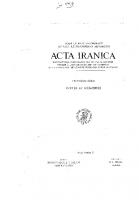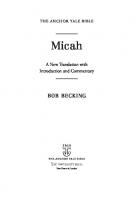The Hymns of Zarathustra: Being A Translation of the Gāthās Together with Introduction and Commentary
139 47 4MB
English Pages 162 [168] Year 1963
Recommend Papers

- Author / Uploaded
- Jacques Duchesne-Guillemin
- Maria Henning (transl.)
File loading please wait...
Citation preview
THE HYMNS OF ZARATHUSTRA
The / Hymns of Zarathustra Being a Translation of the Giithiis together with Introduction and Commentary
By JACQUES DUCHESNE-GUILLEMIN Preface by Richard N. Frye Translated from the French
by Mrs. M. Henning
BEACON PRESS
BOSTON
l3
I
First published in 1952 by John Murray Ltd. First published as a Beacon Paperback in 1963 by arrangement with John Murray Ltd. Printed in the United States of America.
BIBLIOGRAPHICAL NOTE Tms book is a serious attempt by a distinguished modern scholar to translate into a W estem language the traditional hymns of Zoroaster, and so to reproduce as nearly as possible the words which Zarathustra actually spake. The French version and commentary have appeared as part of a book Zoroastre, essai critique avec une traduction commentee des giithiis, Paris, G.-P. Maisonneuve, 1948, to which one may refer for more detailed discussions. The Introduction was published in L'4me de l'Iran, Paris, Albin Michel, 1951.
PREFACE The Gathii.s or hymns of the prophet Zarathustra are exceedingly difficult to translate, and many attempts have been made to interpret them with varying degrees of success. After much study Professor Duchesne-Guillemin gave us a sober and usable rendition of the original in French, and Mrs. Henning, wife of a distinguished Iranist, prepared an eminently readable English version. It is not particularly hazardous to predict that the present work will remain the standard translation into English for years to come, and students of history and religion will be grateful that they have here a reliable guide to the ideas of Zarathustra. This does not mean that there are no problems left in under-· standing the Gathas; indeed difficulties will always remain. What is the nature of the Gathas which makes them so difficult to understand? The Gathas were composed in a dialect close to that of the rest of the Avesta, and also to the language of the Vedas of India. But the contents of the various yasnas or chapters of the Gathii.s are differen~ from the yashts of the so-called ''Younger Avesta.'' The yashts, like the paeans of the Rig Veda, are ancient prayers of adoration, directed to a certain diety (such as Mithra). Like the Vedic hymns, the yashts were probably recited when certain sacrifices were made or certain rites were performec;l. The recitation of the hymns, however, was a solemn obligation for the worshipper since ,a correct delivery was necessary for the proper functioning of the universe. C:::::::The Gathas, on the other hand, seem to represent an innovation V
227968
of the prophet Zarathustra - an innovation in the traditional religion of the Aryans or Indo-Iranian peoples. He ap~ars a~ ~ Q I . between the supreme deity, Ahura Mazdah, and his followers. Zarathustra engages in a discourse with Ahura Maz , 2_ah, and both eschatological and ethical questions come to the
~-
ef
Unfortunately, we do not have an ancient tradition of translations or commentaries by the Zarathustrian priesthood on the Gathiis. Some scholars have suggested that there were prose accompaniments, now lost, to the Gathiis elucidating the often terse poetry. If we knew anything about the early followers of the prophet, we might be able better to reconstruct the milieu, and thus the meaning of the Gathiis for the worshippers. Since the Zarathustrian priesthood, for at least a millennium and a half, has known little more about the Gathiis than present day scholars, the road to understandin the Giithiis lies in com arison with t Sa · · · and in compara~_ve lndoeuropean philology; this is the basis for all work on the Avesta. Duchesne-Guillemin- not only has a solid background of philological work, but he also has a particular point of view on the Gathiis. He is an -exponent of the views of Georges Dumezil of the College de France in Paris, a leading but controversial figure in the study of comparative folklore and religion. According to Dumezil the ancient lndoeuropean peopks / ~ ~Y of belief and ideology parallel to the unity of their ~rious dialects or languages. The ideology of the lndoeuropeans could be characterized under a tripartit~division of the gods, reflecting the tripartite division of lndoeuropean society ,,... on earth . Just as people were divided into ~e.:,ts, warrio~ and c.9mmon folk, so the gods, or patrons of these iv1sions of s.o_ciet-y-, l}ad a tripartite divisi~n. T e i eo og1ca -15as"fo or the philosophy of the tripartite division of society was best expressed by the








![Romans: A New Translation with Introduction and Commentary [33]
0385233175](https://ebin.pub/img/200x200/romans-a-new-translation-with-introduction-and-commentary-33-0385233175.jpg)
